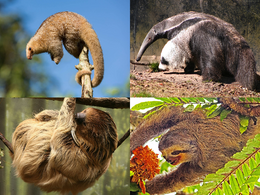The order Pilosa is a clade of xenarthran placental mammals, native to the Americas. It includes the anteaters and sloths (which includes the extinct ground sloths). The name comes from the Latin word for "hairy".
Origins and taxonomy
The biogeographic origins of the Pilosa are still unclear, but they can be traced back in South America as far as the early Paleogene (about 60 million years ago, only a short time after the end of the Mesozoic Era). The presence of these animals in Central America and their former presence in North America is a result of the Great American Interchange. A number of sloths were also formerly present on the Antilles, which they reached from South America by some combination of rafting or floating with the prevailing currents.
Together with the armadillos, which are in the order Cingulata, pilosans are part of the larger superorder Xenarthra, a defining characteristic of which is the presence of xenarthrals (extra formations between lumbar vertebrae). In the past, Pilosa was regarded as a suborder of the order Xenarthra, while some more recent classifications regard Pilosa as an order within the superorder Xenarthra. Earlier still, both armadillos and pilosans were classified together with pangolins and the aardvark as the order Edentata (meaning toothless, because the members do not have front incisor teeth or molars, or have poorly developed molars). Edentata was subsequently realized to be polyphyletic; it contained unrelated families and was thus invalid.
Classification
Taxonomy
Order Pilosa
Phylogeny
Major families within Pilosa
Cladogram of living Pilosa
-
 Data related to Pilosa at Wikispecies
Data related to Pilosa at Wikispecies
-
 Media related to Pilosa at Wikimedia Commons
Media related to Pilosa at Wikimedia Commons
|
|
|---|
|
| Yinotheria |
|
| Theria |
Metatheria
|
|
Eutheria
|
| Xenarthra |
|
| Afrotheria |
|
| Boreoeutheria |
| Laurasiatheria |
- Eulipotyphla (Hedgehogs, shrews, moles and relatives)
- Chiroptera (Bats)
- Pholidota (Pangolins)
- Carnivora (Dogs, cats and relatives)
- Perissodactyla (Horses, rhinoceroses and tapirs)
- Artiodactyla (Pigs, camels, hippos, deer, buffalo, gazelles, giraffes, whales and dolphins)
|
| Euarchontoglires |
- Rodentia (Rats, guinea pigs, squirrels, beavers, chinchillas, porcupines, capybaras and relatives)
- Lagomorpha (Rabbits, hares and pikas)
- Scandentia (Treeshrews)
- Dermoptera (Colugos)
- Primates (lorises, lemurs, tarsiers, monkeys, apes, humans)
|
|
|
|
Extant Pilosa species by suborder |
|---|
|
|
|
|
|
|


